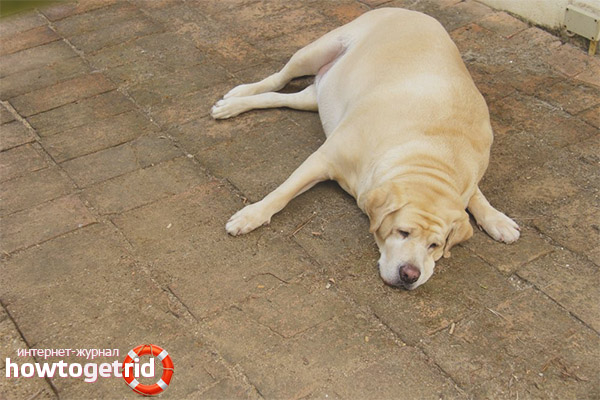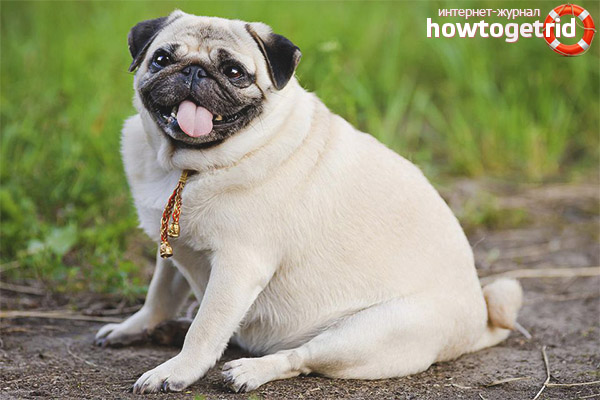The content of the article
Recently quite often owners of dogs complaining about obesity of their pets have come to veterinarians quite often. The reasons for overweight in an animal can be both improper feeding and more serious problems, for example, disruption of the internal organs. It is worth noting that obesity in any case is a dangerous ailment for the health of the pet, and therefore this pathology cannot be ignored.
Traditionally, the treatment of obesity is based on a special diet, as well as an increase in physical activity. The success of losing weight will depend on how strictly you follow all the recommendations of a veterinarian regarding the diet and motor activity of the pet.
What could be the cause of obesity?
The appearance of extra pounds in an animal can occur based on the following reasons and factors:
- Violation of the feeding regimen. The most obvious and common cause of overweight in an animal is overfeeding. Many dog owners themselves become the reason that the weight of the animal is rapidly increasing, because sometimes even a single serving in calories exceeds the norm of calorie consumption by the pet per day. Often the cause of this phenomenon is feeding the animal from the table, feeding various high-calorie treats. If you feed your pet exclusively with natural products, the cause of obesity can be explained by a high fat content in food, as well as a lack of nutritional balance. One of the most common causes of obesity is the predominance of carbohydrates and fats in the diet of animals and a deficiency of protein and minerals.
- Lack of exercise. Often a similar phenomenon is observed in urban pets. Low motor activity as a result leads to the fact that the animal does not have time to spend the calories eaten per day.
- Hormonal diseases. Quite often, adrenal or endocrine gland disorders, as well as diabetes mellitus, become the cause of obesity in dogs. Hormonal imbalance as a result leads to the fact that metabolic processes in the body of the animal become slower, which also leads to an increase in body weight.
- The presence of parasites. It is traditionally believed that parasites in the body, on the contrary, lead to depletion. However, in some cases, invasions secrete toxins that slow the metabolism of the animal, which leads to an increase in body weight.
- Genetic predisposition. Today, there is already reliable evidence that some dog breeds are more prone to obesity than others. These include pugs, French bulldogs, dachshunds, Labradors, beagles and rottweilers. Pet owners of these breeds should be more careful about feeding animals and spend more time on their physical activity.
Constant stress can also provoke obesity. If the animal is often in such a state, then food can become for him a kind of protective tool to help relive experiences. You can notice this feature in pets that were found on the streets or taken from the nursery.
The effects of obesity on an animal
Today, veterinarians unanimously say that obesity is very harmful and dangerous both for health and for the life of the pet as a whole. Obesity can significantly reduce the dog's lifespan.
First of all, overweight harms the cardiovascular system. The heart muscle is forced to work in an enhanced mode, because it comes to pump a much larger amount of blood. In this case, the use of fatty foods leads to a significant increase in cholesterol in the body. As a result of this process, cholesterol plaques form in the vessels, which do not allow blood to circulate normally in the body. In obese dogs, blood pressure rises significantly, and hypertension also develops over time.
A large body mass is reflected in the musculoskeletal system. First of all, the joints begin to suffer. The processes of dystrophy in the spine and limbs are gradually developing. With the appearance of obesity in a dog, one can notice how joint diseases begin to develop over time: arthritis, arthrosis, joint dysplasia, as well as various sprains and tears of the ligamentous apparatus. This affects primarily motor activity, as over time it becomes quite difficult for the animal to walk and especially run.
The absorption of too much fatty food, and indeed overfeeding, will gradually wear out the pancreas, since this body has to work in an enhanced mode. Often it is obesity that becomes a factor in the development of pancreatitis in dogs. Overweight also has a negative effect on liver health. Almost every obese dog develops fatty degeneration.
A large body mass easily leads to thermal shock, a variety of injuries, as well as disruption of the genital organs and weakening of the body's immune defense. According to statistics of veterinary specialists, animals that are overweight live on average one and a half years less than their relatives with normal body weight.
It is also worth noting that the pathological processes that occur in the animal’s body during obesity lead to a slowdown in metabolic processes, as well as a decrease in motor activity, which ultimately leads to even greater obesity and the emergence of new health problems. It is important to timely detect signs of obesity in the pet and take action.
Signs of pathology in dogs
To determine the presence of excess weight in your pet is not difficult, you just need to pay attention to the following signs:
- If you examine your pet, you can find that the last two ribs can not be viewed. It is also impossible to determine the border between the chest and the abdomen by examination.
- When probing the ribs can be determined with great difficulty.
- The belly of the pet becomes quite swollen and sagging, the back becomes curved.
- The legs of the dog gradually become short and thick.
- Gradually, the dog appears additional folds, which previously were not, and which are not provided for by this breed.
- Over time, the pet becomes inactive, does not seek walks, does not play, as before.
- Even a little physical activity causes shortness of breath in the dog.
- During walks, the animal can often lie down to rest.
- In males, a decrease in sexual desire may be observed.
- Females, in turn, may experience abnormalities in leakage mode, and sometimes they may be completely absent.
- The mass of the animal exceeds the breed standards by 20% or more.
If, despite the description of all the symptoms, it is still quite difficult to determine obesity in a pet, you should consult a veterinarian. A specialist will inspect the animal and make a conclusion.
How to understand what weight is ideal for an animal?
To understand that your pet is overweight is quite simple, having at its disposal information about the standard indicators of a particular breed.It is enough to know the breed, sex and age of your pet to determine what weight he should have approximately. If you find that your pet’s body weight exceeds your permissible limits by 20%, you should consider a correction.
How to treat an animal for obesity?
Since obesity entails the development of a large number of pathological processes, it is necessary that the treatment of the animal be supervised by a veterinarian. Moreover, losing weight is a rather long and complex process.
As a rule, the basis of treatment for obesity is a special therapeutic diet, as well as physical activity. If obesity is a consequence of the development of a disease of the internal organs, then the pathology detected is mainly treated.
How to choose a diet and feed?
The veterinarian selects a nutrition plan for combating obesity, taking into account the age, breed, gender and degree of obesity of the animal. There are some general rules for nutrition when losing weight:
- If the animal was fed only with natural products during the course of therapy, then lean meat and poultry, as well as cereals with a low calorie content, should be selected in the course of therapy, buckwheat and oatmeal are perfect. Protein food should make up about 40% of the total diet, and cereal crops about 20%. Sour milk products, as well as raw and boiled vegetables, must be added to the pet's menu. Also, a veterinarian can prescribe the use of vitamin complexes.
- During the diet, you should completely stop feeding the animal from the table. It is forbidden to give the pet sausages, flour products, salty, gifted and fatty.
- It should also reduce the portion of the pet. This should be done gradually. Initially, it can reduce the diet by 10-15%. If you have a large breed dog, then you can feed it three times a day, small breeds need 4 meals a day.
- It is strictly forbidden to drastically restrict a pet's diet or starve. Not only will this not give any result, in addition, the animal may develop pancreatitis, liver or stomach diseases.
- If your pet is fed ready-made feeds, special attention should be paid to the dosage of the feed. Most often, during the diet, the veterinarian prescribes the use of special food for weight correction. Such foods are distinguished by the fact that they have a relatively low calorie content, despite the fact that they are completely balanced.
In addition to the feed itself, the doctor also determines the portion size. It is important to understand here that increasing the weight of a serving will not lead to positive changes, so it is important to strictly follow the recommendations of a specialist.
Physical activity
Exercise will help your pet lose weight quickly and without any harm to health. Increase the activity of the pet should be gradually as he loses weight. Doctors generally recommend starting with an increase in the length of walks.
As soon as the animal gets used to such a load, you can add additional types of activity: running, various games, overcoming obstacles, jumping and more. In the warmer months, water treatments will be very beneficial.
If you have an obese animal, you can contact the cynological complex for help, specialists will help you develop a set of physical exercises for losing weight.
Video: how to lose weight with a dog












Submit